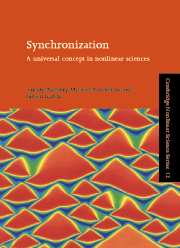Book contents
- Frontmatter
- Contents
- Preface
- Chapter 1 Introduction
- Part I Synchronization without formulae
- Part II Phase locking and frequency entrainment
- Chapter 7 Synchronization of periodic oscillators by periodic external action
- Chapter 8 Mutual synchronization of two interacting periodic oscillators
- Chapter 9 Synchronization in the presence of noise
- Chapter 10 Phase synchronization of chaotic systems
- Chapter 11 Synchronization in oscillatory media
- Chapter 12 Populations of globally coupled oscillators
- Part III Synchronization of chaotic systems
- Appendices
- References
- Index
Chapter 8 - Mutual synchronization of two interacting periodic oscillators
Published online by Cambridge University Press: 06 July 2010
- Frontmatter
- Contents
- Preface
- Chapter 1 Introduction
- Part I Synchronization without formulae
- Part II Phase locking and frequency entrainment
- Chapter 7 Synchronization of periodic oscillators by periodic external action
- Chapter 8 Mutual synchronization of two interacting periodic oscillators
- Chapter 9 Synchronization in the presence of noise
- Chapter 10 Phase synchronization of chaotic systems
- Chapter 11 Synchronization in oscillatory media
- Chapter 12 Populations of globally coupled oscillators
- Part III Synchronization of chaotic systems
- Appendices
- References
- Index
Summary
In this chapter we consider the effects of synchronization due to the interaction of two oscillating systems. This situation is intermediate between that of Chapter 7, where one oscillator was subject to a periodic external force, and the case of many interacting oscillators discussed later in Chapters 11 and 12. Indeed, the case of periodic forcing can be considered as a special case of two interacting oscillators when the coupling is unidirectional. However, two oscillators form an elementary building block for the case of many (more than two) mutually coupled systems. The problem can be formulated as follows: there are two nonlinear systems each exhibiting self-sustained periodic oscillations, generally with different amplitudes and frequencies. These two systems can interact, and the strength of the interaction is the main parameter. We are interested in the dynamics of the coupled system, with the main emphasis on the entrainment of phases and frequencies.
In Section 8.1 we develop a phase dynamics approach that is valid if the coupling is small – the problem here reduces to coupled equations for the phases only. Another approximation is used in Section 8.2, where the dynamics of weakly nonlinear oscillations are discussed. Finally, in Section 8.3 we describe synchronization of relaxation “integrate-and-fire” oscillators. No special attention is devoted to coupled rotators: their properties are very similar to those of oscillators.
Phase dynamics
If the coupling between two self-oscillating systems is small, one can derive, following Malkin [1956] and Kuramoto [1984], closed equations for the phases. The approach here is essentially the same as in Section 7.1. It is advisable to read that section first: below we use many ideas introduced there.
- Type
- Chapter
- Information
- SynchronizationA Universal Concept in Nonlinear Sciences, pp. 222 - 235Publisher: Cambridge University PressPrint publication year: 2001
- 1
- Cited by

